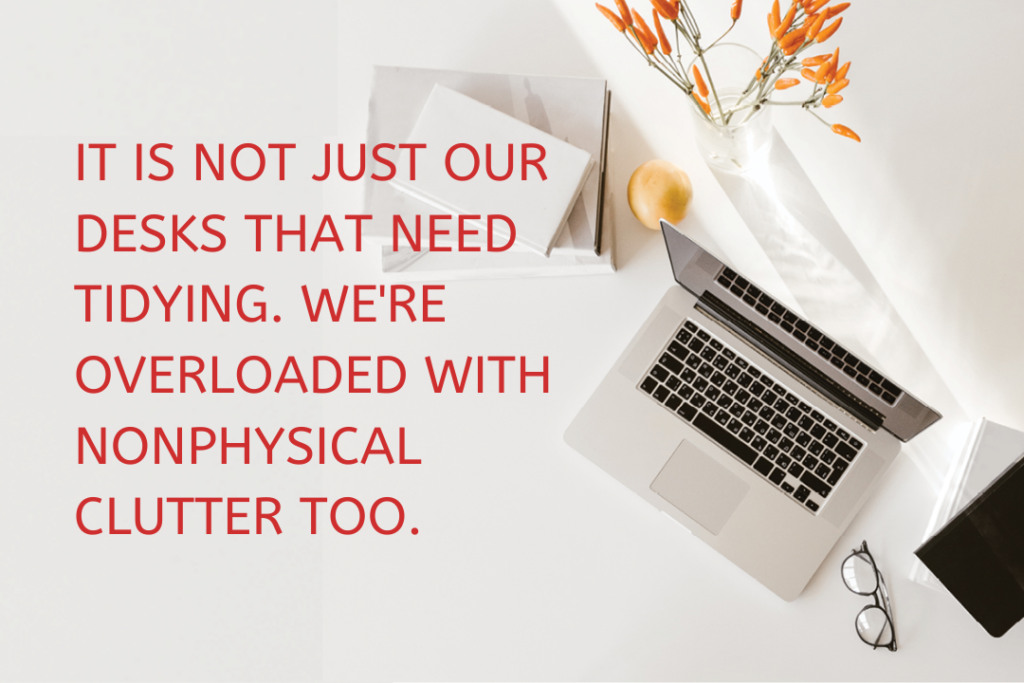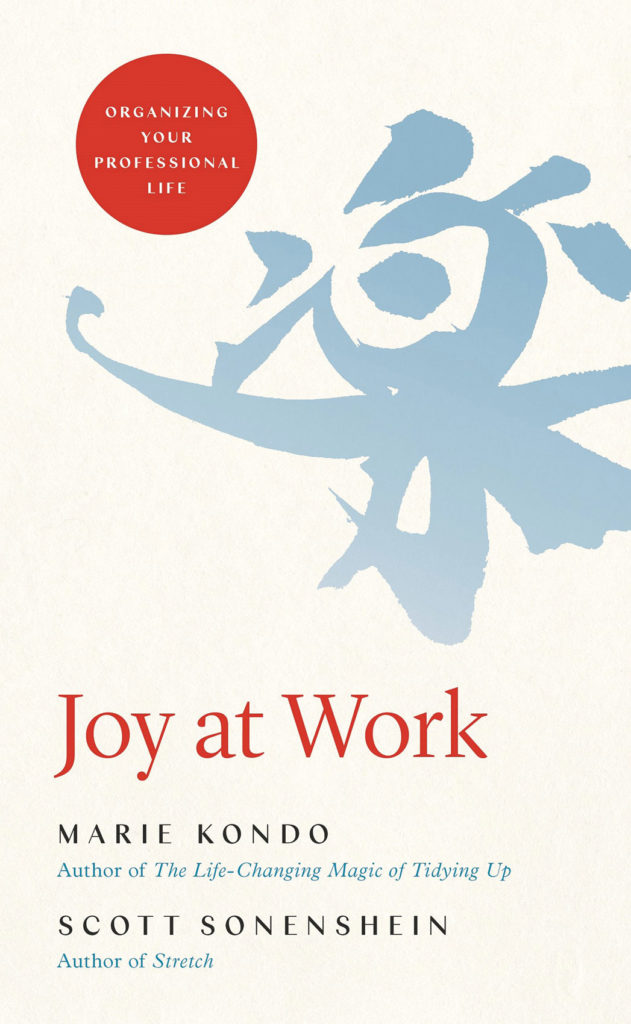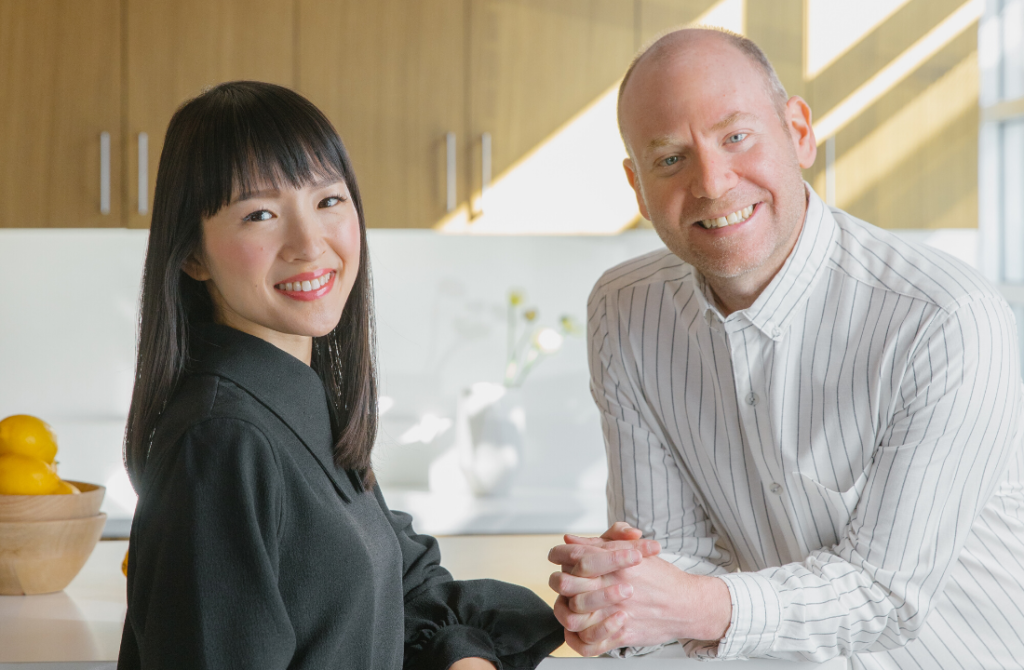“If a cluttered desk is the sign of a cluttered mind, of what, then, is an empty desk a sign?”
These words have been attributed to the creative genius and physicist Albert Einstein. Regardless of whether he actually said this, his desk appears to have been buried under piles of books and papers. Similarly, Pablo Picasso painted while surrounded by a jumble of paintings. Steve Jobs, the founder of Apple, reportedly kept his office cluttered on purpose. Legends of geniuses with messy offices are too numerous to mention. As if to corroborate these, a recent study conducted by researchers at the University of Minnesota concluded that a messy job setting is more likely to generate creative ideas.
Perhaps because such stories abound and run counter to The Life-Changing Magic of Tidying Up and her KonMari Method, people frequently ask Marie Kondo for confirmation. “But a cluttered desk is good, isn’t it?” they’ll say. “It stimulates creativity, right?”
Here’s a little exercise for you to try. Start by mentally picturing your desk at the office, your studio or your workplace. Next, answer these questions.
- Are you honestly feeling positive about working here right now?
- Does working at this desk every day really spark joy for you?
- Are you sure that you’re giving full scope to your
- creativity?
- Do you really want to come back to this tomorrow?
These questions aren’t intended to make you feel bad. They’re meant to help you get in touch with how you feel about your work environment. To be honest, it doesn’t really matter which is better—a clutter-free desk or one that is total chaos. The most important thing is that you are aware of the kind of environment that brings you joy at work, that you know your own joy criteria. Tidying is one of the best ways to find out.
Many clients who have used the KonMari Method to tidy up their homes end up with a bare and simple interior when they’re done, only to realize a little later that they want more decoration. That’s when they begin adding accents they love. Often, it is only after tidying up that people realize what kind of environment sparks joy for them.
But a major difference between our home and workspace is that at work, people can see us. At home, almost no one sees our clothes or books, even if they are strewn all over the floor. But an office is a shared space, which makes the difference between a tidy desk and a messy one obvious to all. Surprisingly, this fact has a much greater impact on our working life than most people realize.
Several studies on employee evaluations in the workplace have shown that the tidier a person’s space, the more likely others are to see them as ambitious, intelligent, warm and calm. Yet another study showed that such people are seen as confident, friendly, industrious and kind. The list of adjectives makes these people sound like real winners.
The findings of these studies can be summarized in three single points. A tidy desk results in a higher evaluation of our character and capacity. This raises our self-esteem and increases our motivation. As a result, we work harder and our performance improves. Looked at in this way, tidying up sounds like a pretty good deal, doesn’t it?
It is not just our desks that need tidying. We’re overloaded with nonphysical clutter too. In particular, modern technology has generated digital clutter in the form of excess emails, files and online accounts.
According to one study, a typical office worker spends about half of his or her day dealing with emails and averages 199 unopened emails in the inbox on any given day. An average internet user has 130 online accounts per email address. The average office worker wastes two hours and 39 minutes a week in ineffective meetings. The cost of such unproductive meetings comes to more than $3.7 billion annually. The loss in productivity from forgetting or mislaying passwords comes to at least $420 per employee annually. In a company that employs 25 people, that amounts to more than $10,000 per year.
Many people feel defeated at the mere suggestion of tidying up. “I can’t possibly make time for that! I’m far too busy already,” they protest. Others claim, “I’ve already tried it. I sorted all my documents and now they’re just a mess again.”
Quite a few people don’t believe they can find joy in their job. “I’m stuck in useless meetings all day long. Tidying’s never going to change that,” they insist. In fact, it’s tidying up properly that makes it possible to spark joy at work.
THE KONMARI METHOD AT WORK
Since the age of 5, I’ve been fascinated by tidying. I pursued this subject through my school years and went on to take my first steps as a tidying consultant at 19 while still at university. The KonMari Method arose from my experiences of teaching people how to tidy up.
My approach has two distinct features: It’s simple but effective, ensuring you’ll never revert to clutter, and it uses a unique selection criterion—choosing what sparks joy. When we ask ourselves, Does this spark joy? we reconnect with our inner self and discover what’s really important to us. The result is a lasting change in behavior that sets life on a positive track.
Of course, not everything at work can be evaluated on the basis of whether it sparks joy. There are company rules to follow, perhaps superiors who make decisions that impact our work, and coworkers with whom we collaborate. Nor is tidying our physical workspace enough to make our jobs go smoothly. We can only truly spark joy in our work life when we have put every aspect of it in order, including emails, digital data, work-related tasks and meetings.

I have witnessed how tidying can transform many aspects of my clients’ work life. One client, for example, remembered her childhood dream while tidying up her books and quit her job to start her own company. This was simply the result of examining each thing in front of her and choosing whether to keep it in her life or let it go.
Tidying is much more than sorting things and putting them away. It’s a major project that will change your life forever. This process will help you see how each task you do is linked to a joyful future. In the end, the real goal is to discover what brings you joy in your work so you can give it your best. Ready?
TIME
We can shorten our workdays and add joy to our work if we learn to get ahold of activity clutter. Activity clutter comes from the things we do that take up precious time and sap our energy but don’t make a meaningful difference. On average, we spend less than half our workday on our main job responsibilities, with the rest of our time taken up by interruptions, nonessential tasks, administrative tasks, emails and meetings.
They can largely be categorized into three common traps:
1. Overearning Trap:
Earning rewards and being competitive is a part of who we are, but it can derail us easily. When deciding how to spend your time, remember: Don’t trade an activity you love to pursue a reward you don’t value.
2. Urgency Trap:
Instead of making time to dive deeply into our work and experience the joy that can come from tackling an important task, we jump from one seemingly urgent task to the next one. That leaves us with very little time to think or grow.
3. Multitasking Trap:
Multitasking decreases productivity by as much as 40 percent. Those who multitask are typically the least capable of doing it successfully. The human brain can think about only a limited number of things at once.
DECISIONS
No matter what type of work you do, you make thousands of decisions each day. Some researchers estimate that the number is upward of 35,000. But a recent survey finds that people, on average, recall making only about 70 of them.
When considering your many work decisions, follow these simple steps: Forget about the small decisions, sort and organize the medium decisions and reserve your mental energy for the high-stakes ones.
Begin with low-stakes decisions. If you don’t think the outcome of a decision will make a difference, don’t invest a lot of time making it. Next, gather up all the medium- and high-stakes decisions you currently or will soon face. The high-stakes ones usually pop out, and for most people there will only be a handful of these. These are decisions that will have a big impact on your work or life and deserve your time and energy. Now you’re left with medium-stakes decisions, and it’s time to figure out which ones are truly worth keeping. Be choosy about what you spend your time and energy on. You might realize that what you previously viewed as an important decision either shouldn’t be made or should be made by someone else.
SOCIAL MEDIA
One of the most important points in building a joyful network is knowing what kind of connections you enjoy. For example, some people love being surrounded by friends and having fun together. Others prefer to have deeper relationships with just a few people. I fall into the latter category. I’m not very good at keeping in touch, and I feel more comfortable with fewer relationships.
Using the KonMari Method, I looked at each name in my social network and kept only those that sparked joy. In the end, I was left with only 10 people, excluding my family and people whose contacts were essential for work. I was stunned at how many names I eliminated, but afterward, my heart felt much lighter and I was better able to nurture those relationships that I had chosen to keep.
Just as you would to create a joyful lifestyle, choose what sparks joy and take care of what you decide to keep—you need to do both to build a joyful network. When you feel something’s not quite right with your network, see that as a sign. Believe that you can have a more fulfilling life and contribute more to the lives of others when you are comfortable. Then say goodbye with gratitude to any relationships you no longer need and nurture those that you decide to keep.
MEETINGS
When you step into a meeting, you’re entering a shared space for collaboration, decision-making and exchanging ideas. Treasure this space and it will turn into a source of joy.
Rule #1: Show up. Really show up.
Sit up straight, pull yourself close to the table and radiate positive energy. This is not the time to let your mind wander.
Rule #2: Come prepared.
If you feel like you don’t have enough time to prepare yourself, you probably don’t have time to attend the meeting either.
Rule #3: Put away your electronics.
Seriously, we all see you sneaking a peek at your phone. If you focus on the meeting, it will be shorter, more effective and more enjoyable.
Rule #4: Listen… really listen.
We should be able to learn from one another during meetings. That’s pretty hard to do because we all enjoy talking.
Rule #5: Speak up.
There are times when you have unique information to share. Focus on advancing the conversation with new information, a different perspective or putting the discussion back on track.
Rule #6: Do no harm.
We’re responsible adults. Blaming others, cutting them off or self-promoting creates dysfunction.

TEAMS
Big teams can create big messes. Research shows that larger teams are less satisfying than smaller ones. With so many other people around, there’s a good chance that there will be a lot of overlap in members’ contributions, making it more likely that teams become chaotic and disorganized. Also, it’s hard to stand out and see the impact of our own work with too many people around.
A bigger team is also almost always a slower one. Trying to reach a consensus with a big team takes a lot of time, and sometimes it isn’t even possible. Amazon CEO Jeff Bezos lives by the “two-pizza rule”—no team should be large enough that it needs to be fed with more than two pizzas. Studies peg the optimal size for most teams between four and six people if they’re trying to generate ideas, make decisions or innovate.
Although teams can be a source of joy for all their members, they too commonly fall short of their promise. Know that the success of a team is everyone’s responsibility, no matter their job title, seniority or tenure—and a privilege for us to enjoy at work.
INSPIRE TIDINESS
Scott Sonenshein’s office used to be a mess. He had way too many books, even for a professor. He hadn’t touched most of them for years. Stacks of research articles piled so high, they blocked his view. His desk drawers rivaled a bad convenience store—snacks well past their prime and years-old office supplies still in their packaging. He even had a mysterious key; to this day, he has no idea what it opens.
After he tidied his office, colleagues were absolutely shocked. “Wow, what happened?” they asked. “Your office looks amazing!” They too wanted a space filled only with items they loved. Sharing his office was just the beginning. Sonenshein had higher ambitions for people to tidy all aspects of their work.
Although you can’t force tidying upon others, you can inspire them by sharing all that you’ve accomplished. Tell your colleagues about your tidying journey and fill the rest of the office with more joy. Teach your techniques to those who want to learn. Share how tidying has transformed your work and life—and you’ll soon have others eager to transform their own.
* * *
Tidying comes as naturally as breathing to Kondo. It’s so much fun for her. Yet it hasn’t all been smooth sailing. Her passion for tidying began at the age of 5, but it took many years of trial and error to develop her method and reach where she is today.
Work is based on accumulated experience. Through working, we grow. Nothing is all thrills right from the start. Even if something is not going well or doesn’t feel right at this moment, if it is leading you toward a future that sparks joy, then think of it as a growing pain. If your work life doesn’t spark joy all the time, don’t assume that you’re a failure. Instead, recognize the potential of this moment to bring you closer to your ideal, enjoy the process and celebrate the fact that you’re still growing. Be confident that you are creating a joyful work life right now through the daily process of acquiring experience.
Kondo is convinced that tidying is the first and most effective step toward realizing your vision of a joyful career. Finish tidying up your workspace, and then devote yourself to what you love. Joy at work sparks joy in life.

Adapted from JOY AT WORK. Copyright © 2020 by Marie Kondo and Scott Sonenshein. Used with permission of Little, Brown Spark. New York, New York. All rights reserved.
This article originally appeared in the May/June 2020 issue of SUCCESS magazine.
Photo courtesy of Konmari Media, Inc.








